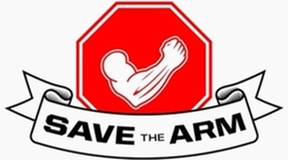1. Develop a system to pre- identify all patients with CKD, lymphedema or other conditions where arm protection is desired. Examples of this include building and maintaining registries of patients who require arm protection and educating staff about the importance of identifying patients in a systematic fashion prior to any invasive upper extremity action in order to avoid injury.
2.Provide patient education consistently regarding the importance of arm protection using Save The Arm or other similar educational materials. Give patients with CKD, Lymphedema or other conditions a Save The Arm Wallet Card or Save the Arm Alert Safety Sleeves.
3. Use physical devices consistently in all clinical settings such as Save the Arm “Alert” Safety Tape and Save the Army “Alert” Safety Sleeves, to alert staff and reinforce patient education. Place Save the Arm Alert stickers in patients charts and use Save The Arm Alert notifiers in the EMR. Place Save the Arm alert placards outside of patient’s rooms and on and over the bed in patients rooms who require Save The Arm intervention.
4. Provide educational materials such as Save The Arm education materials or other materials to patients with CKD, lymphedema, or other conditions where arm protection is desired, consistently at each office visit or hospitalization. Have patients go to the save The Arm website and register. Here they can download information and discuss with their friends and colleagues.
5. Measure compliance with the use of physical devices and the distribution of educational materials over time and attach to outcome measures. For example, measurement of process measures includes things like the percentage of patients with CKD, lymphedema, and other conditions where protection of an arm is desired, who received educational materials and physical protective devices each time they presented to a medical facility. An outcome measure, might be the number of patients who suffered preventable injury due to undesired IV access, PICC line placement and/or trauma or injection to an arm that should have been protected. By making injuries and near misses visible ot health staff, it creates an opportunity to eradicate future injury and near misses.
6. Tell patient stories of success and as well where success did not occur to educate and build will among clinical staff for Arm Protection and partner with patients with CKD, lymphedema, and other conditions where protection of the arm is desired, to help reinforce clinical behaviors.
7. Create pre-phlebotomy, pre-PICC line placement, pre-IV access and pre injection checklists which incorporate either the 5 A’s or the EASE methodology and include the following as a minimum:
a. Identification prior to procedure if the patient is a candidate for such access or procedure.
b. If patient is identified as having a protected arm, consistent charting and applying visual/physical cues to alert other staff to avoid interventions in that particular arm.
7. Discuss arm protection and develop appropriate strategies with risk management, quality improvement and leadership to assure that arm protection is an institutional prerogative.
8. Create a learning culture of reporting misses and near misses. Ideally this culture should focus on understanding and improving the system and should not concentrate on assigning blame. Near misses in particular should prompt careful and rapid reassessment of a healthcare organizations process stability.
9. Make public the results of process improvement efforts in arm preservation, and make all elements of an organization aware of how highly reliable process measures lead to more reliable and successful outcome measures.
10. Listen to patients and providers and solicit feedback regarding ways in which arm preservation could be made even more effective.



